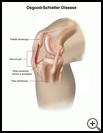
Osgood-Schlatter Disease
________________________________________________________________________
KEY POINTS
- Osgood-Schlatter disease causes pain and swelling just below the knee and over the bump at the top of the shinbone, where the growth plate of the shinbone is located. The growth plate can be injured suddenly or be slowly damaged over time.
- Your child may need to rest or do activities that don’t cause knee pain.
- Symptoms of Osgood-Schlatter disease usually go away when the child stops growing. Your child's healthcare provider may recommend stretching and strengthening exercises or a special padded brace to help the knee heal.
________________________________________________________________________
What is Osgood-Schlatter disease?
Osgood-Schlatter disease is a problem with the top of the shinbone where it attaches to the kneecap tendon. Tendons are strong bands of tissue that connect muscle to bones. Osgood-Schlatter disease causes pain and swelling just below the knee and over the bump at the top of the shinbone, where the growth plate of the shinbone is located.
The growth plate can be injured suddenly or may be slowly damaged over time. Your child can have tiny or partial tears in the growth plate.
Osgood-Schlatter disease is seen most often in boys between the ages of 10 and 15. It usually appears when your child goes through a growth spurt.
What is the cause?
Osgood-Schlatter disease is caused by overuse of the patellar tendon. Overuse can cause irritation of the growth plate or of the area where the tendon attaches to the bone. It can lead to extra bone formation. Sometimes the extra bone is in pieces.
Overuse can happen during normal childhood and sport activities. It may happen when the muscles are too tight in the front of the thigh, the back of the thigh, or in the calf.
What are the symptoms?
Your child will complain of a painful, hard bump below the kneecap. The pain may come and go, or the bump may stay painful. Some activities, such as kneeling, may be hard to do.
How is it diagnosed?
Your child's healthcare provider will examine your child and ask about your child’s symptoms, activities, and medical history. Your child may have the following tests:
- X-rays of the knee
- MRI, which uses a strong magnetic field and radio waves to show detailed pictures of the knee
How is it treated?
Symptoms of Osgood-Schlatter disease usually go away when the child stops growing. This is about 6 to 24 months after your child starts having symptoms. Your child may need to rest or do activities that don’t cause knee pain. Your child will always have a bump even after the pain has gone away.
Your child's healthcare provider may recommend stretching and strengthening exercises to help the knee heal. A special padded brace may help. Ask your child’s provider about this.
Sometimes the pain from Osgood-Schlatter disease lasts into adulthood. Adults with pain from pieces of bone in the knee may need surgery to remove the pieces of bone.
How can I take care of my child?
To help the swelling and pain:
- Put an ice pack, gel pack, or package of frozen vegetables wrapped in a cloth, on the area every 3 to 4 hours for up to 20 minutes at a time.
- Keep your child’s knee up on a pillow when sitting or lying down.
- Give nonprescription pain medicine, such as acetaminophen, ibuprofen, or naproxen. Read the label carefully and give your child the correct dose as directed.
- Nonsteroidal anti-inflammatory medicines (NSAIDs), such as ibuprofen, naproxen, and aspirin, may cause stomach bleeding and other problems.
- Check with your healthcare provider before you give any medicine that contains aspirin or salicylates to a child or teen. This includes medicines like baby aspirin, some cold medicines, and Pepto-Bismol. Children and teens who take aspirin are at risk for a serious illness called Reye’s syndrome.
- Acetaminophen may cause liver damage or other problems. Do not give more doses than directed. To make sure you don’t give your child too much, check other medicines your child takes to see if they also contain acetaminophen. Unless recommended by your healthcare provider, your child should not take this medicine for more than 5 days.
Your child should do the exercises recommended by your healthcare provider.
Follow your healthcare provider's instructions. Ask your provider:
- How and when you will get your child’s test results
- How long it will take your child to recover
- If there are activities your child should avoid, including how much your child can lift, and when your child can return to normal activities
- How to take care of your child at home
- What symptoms or problems you should watch for and what to do if your child has them
Make sure you know when your child should come back for a checkup.
How can I help prevent Osgood-Schlatter disease?
Medical experts don’t know how to prevent Osgood-Schlatter disease. The best way to prevent pain is to build muscle strength with exercise. Proper warm-up and stretching exercises of the thigh, hamstring, and calf muscles may also help.
Your child should avoid overtraining by limiting activity as soon as he notices the painful bump on the top of the shinbone.
Last modified: 2019-12-18
Last reviewed: 2018-11-09

